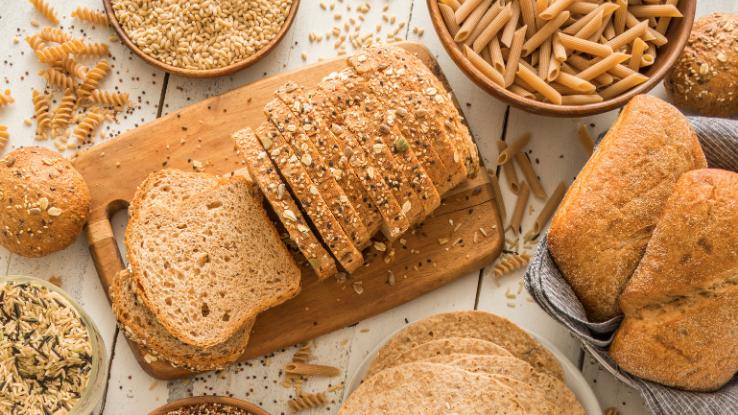
You might think the only differences between whole wheat and white bread are superficial things, like texture and taste. But it’s also true that whole wheat bread gets touted as the healthier option. So, are the extra health benefits of wheat bread worth sacrificing the soft, smooth texture, and rich taste of white bread? Is all wheat bread the same?
Whole wheat bread is made from whole wheat grains, or whole grains, which have numerous health benefits, more so than white bread made from refined grains. But it’s not always clear from the package what you’re getting into, which is why we’re exploring what “whole grain wheat” really means and how you can choose the best whole grain products for your health.
What Are Whole Wheat Grains?
The wheat grain, like other grains, consists of three main parts: the bran, the germ, and the endosperm. The bran is the outer layer and it is rich in fiber, B vitamins, minerals, antioxidants, and phytochemicals — natural chemicals in plants that have numerous roles in preventing disease. The germ is the part of the seed where growth would occur if the wheat were pollinated, and contains healthy fats, vitamins B and E, antioxidants, and phytochemicals. Finally, the endosperm is the inner layer and it mainly comprises protein, starch, and small amounts of vitamins and minerals.

Once the grain is processed and milled, most of the bran and germ are removed, leaving just the starchy endosperm. The resulting “refined” white flour is soft and great for baking, making fluffy, soft breads and pastries. However, the milling process removes almost all the fiber, more than half of the vitamin B, and most of the vitamin E. Sometimes, the manufacturer will add vitamins and minerals back to the bread (often called “enriched” bread) but many of the beneficial components of the whole grain cannot be replaced. As a result, refined grains don’t offer the same health benefits as whole grains.
Health Benefits of Whole Grains
According to the United States Department of Agriculture (USDA), a daily diet that includes a regular intake of whole grains can reduce the risk of chronic diseases, while maintaining the health and proper function of the body. Whole grains tend to be heartier and more filling than refined grains, and are a great alternative to foods higher in fat. Some studies have shown a correlation between regular whole grain intake and reduced risks of heart disease, cancer and diabetes.

Here is an in-depth look at the health benefits of whole wheat grains:
Fiber:
Whole grains are rich in fiber, which can help reduce the risk of coronary heart disease. Fiber reduces the risk of heart attacks and stroke by preventing the formation of small blood clots. Fiber can also help keep proper function of the digestive tract and lower LDL (bad) cholesterol and triglycerides. When substituted for foods high in fat, whole wheat grains can help people maintain a healthy weight. Consuming whole grain products results in higher concentrations of “good” gut bacteria, which improve the metabolism.
Vitamins:
The B vitamins found in whole grains help with the body’s metabolism by breaking down fat, protein and carbohydrates for energy. B vitamins are also needed for a strong nervous system. Vitamin E is an important antioxidant, and a lack of vitamin E can impair immune responses.
Antioxidants:
Whole grains contain more antioxidants than some fruits and vegetables.
Iron:
Iron is needed to carry oxygen in the blood, and those with an iron deficiency in their diet should seek out foods containing a significant amount of iron such as whole grain foods.
Magnesium:
Whole grains contain magnesium, which is used for building bones and releasing energy in muscles.
Phytochemicals:
Some phytochemicals (eg, flavonoid, ferulic acid, zeaxanthin, lutein) in whole grain wheat may protect against some cancers.
Whole Grain Food Sources
Now that you know how great whole grains are, the next thing to do is learn where you can find whole grains in your food. The most common food sources for whole grain wheat are whole wheat bread and pasta. As well as wheat, other health-beneficial grains include brown rice, popcorn, whole oats, barley, bulgur, rye, buckwheat, quinoa, and spelt.

When shopping for whole grain products, remember:
Buy products labeled…
- “whole wheat”
- “100% whole grain”
- “100% whole wheat”
Avoid products labeled…
- “wheat flour”
- “stone-ground”
- “multigrain”
- “bran”
- “wheat germ”
- “unbleached white flour”
- “100% wheat”
While we might think of “brown bread” as healthier than “white bread,” color alone does not indicate the presence of whole grains. Bread might be brown because molasses or caramel coloring has been added to it. Some whole-grain products, such as hot cereal, might be pale in color. If you prefer the look of white bread, you can now find white whole-wheat bread that is made from whole grains. Just make sure “whole wheat” is listed as the first ingredient on the nutrition label.
How Many Servings of Whole Grains Should You Eat Per Day?
The 2015–2020 Dietary Guidelines for Americans suggest making “half your grains whole,” which translates to eating three or more servings of whole grains per day. This is just a suggested average, however, and active people should increase their daily intake of whole grains to four or five servings per day. Fortunately, there are many ways to incorporate more whole grains into your diet with new whole grain products including crackers, cookies, chips, muffins and pancakes.

According to the Whole Grains Council, one serving of whole grains is
- 1 ounce or 1 slice of 100% whole grain bread
- 1 cup of 100% whole grain cereal
- ½ cup of oatmeal
- ½ cup of brown rice
- 3 cups of popcorn
- 1 whole wheat English muffin
- 1 cup of cooked quinoa
A 2017 review of published studies on the health benefits of whole grains indicated that consuming two to three servings per day of whole grains could be beneficial in preventing heart disease, type 2 diabetes, and colorectal, pancreatic and gastric cancers. Now you can make an informed choice at the grocery store and choose whole grains for a host of health benefits.
Resource Links:
- “Whole Grains” via Harvard University, School of Public Health
- “Standards of Diabetes Care” via American Diabetes Association
- “Whole Grains Fact Sheet” via Food Insight
- “Health Benefits of Dietary Whole Grains: An Umbrella Review of Meta-analyses” via ScienceDirect
- “The Impact of Whole Grains on Health” via Today’s Dietitian
- “How can bread be labeled as both white and whole wheat?” via Mayo Clinic
- “Myths Busted: Why White Bread Is Not Just as Healthy as Whole Grain Bread” via Whole Grains Council
- “Grains” via MyPlate.gov, U.S. Department of Agriculture (USDA)
- “Don’t Give Up on Grains” via Harvard University, Harvard Medical School
- “How Much Whole Grain Is Enough?” via Whole Grains Council





